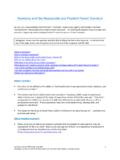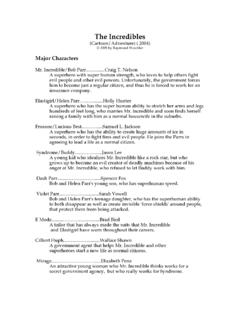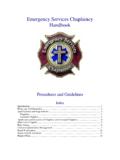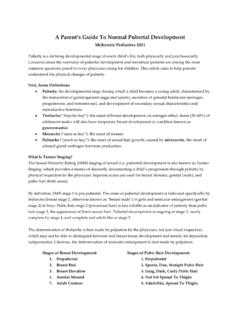Transcription of Equine Reproduction Embryo Recovery EQUINE …
1 EQUINE Reproduction Embryo Recovery Embryo Transfer EQUINE Reproduction SVC ERS is the longest, continually in existence EQUINE Embryo Transfer Company in the United States 817 946 5132 Protocol - On Farm Embryo Transfer Program Embryo transfer is not rocket science. It is a relatively simple process, provided you pay attention to details. There are some short cuts that can be taken within a breeding program. However, if you follow the same practice with Embryo transfer, it will not work for you. Embryo transfer can become a valuable tool in your breeding program if you "are willing" to work at it .. just a little bit. It is understood that the owner of the ranch / farm (or his agents) have a working understanding of Reproduction in the mare and its related terminology. It is also understood that this protocol's purpose is to help you ready your mares for Embryo transfer.
2 It is not intended as a home study course in Embryo transfer or to give you credit towards your PhD in theriogenology. Therefore, it is important that your veterinarian review this paper with you. I realize that most, if not all, Embryo transfers undertaken by clients of EQUINE Reproduction Service (ERS) will be performed on a breeding farm (whether large or small). Although much of the contain information on Reproduction in the mare may be repetitious to breeding farm personnel, I recommend that these guidelines be read and studied in their entirety. It is imperative that the services and advice of a technician experienced in broodmare practice be obtained to realize the benefit of the following undertaking. BASIC NORMAL REPRODUCTIVE PHYSIOLOGY OF THE MARE The mare exhibits normal estrus cycles starting in late spring continuing through summer and into early fall.
3 In early spring (especially) and late fall the majority of mares will become transitional with erratic reproductive behavior, long heats and lowered fertility. Through the winter months most mares become anestrous (absence of reproductive function). We will be concerned with the OVULATORY SEASON or the time of year when the mare experiences normal cyclic activity, "breeding season". The estrus cycle in mares averages 22 days in length from the day of ovulation (rupture of a follicle within the ovary and the release of the ovum (egg) to the following ovulation in the next cycle. The time the mare is in estrus (heat or sexually receptive to a stallion) averages 4-7 days, longer early and late in the breeding season and often two or more days shorter during the mid-summer months. Diestrus (period of time the mare is "out" or sexually non-receptive to the stallion) averages 15-17 days.)
4 This cyclic activity continues throughout the breeding season until late fall with the mare then becoming anestrous or until pregnancy ensues. When ovulation occurs, there is hemorrhage into the space once occupied by the follicle, a fluid filled cavity within the ovary containing the ovum or egg. The fluid portion containing [as a part of its make-up] estrogen a hormone which, among other functions, is responsible for the mare's showing of heat and preparing her reproductive tract for breeding. The new organ produced by the ovulating follicle and the resultant hemorrhage once it organizes is called a "corpus luteum" (CL). The CL's function is to produce progesterone. Within a day or two after ovulation the mare will go out of estrus and will no longer accept the stallion. The Diestrus phase of the cycle now begins. If the mare is not pregnant or has not been bred, about the fifteenth day of Diestrus the uterus releases a natural substance called prostaglandin, resulting in autolysis or destruction of the CL.
5 This allows the development of the next ovulatory follicle. If the mare is pregnant, substances (steroids) from the developing Embryo and the fact, in early pregnancy, that the Embryo is highly mobile block the natural prostaglandin release and the mare does not return to estrus. ACQUISITION & QUALIFICATION OF RECIPIENT MARES Although one recipient mare will work for one donor you might have to lose a cycle or two to get them synchronized together. Two recipients per donor is good. More better. Recipient mares may be acquired through many methods. They may be purchased or borrowed from friends or neighbors. Recipient mares may be purchased through local sales. Mares not destined for the broodmare band and of limited value would also make excellent candidates. Recipient mare candidates in a perfect world would be 5 to 7 years old and of sufficient physical size to be able to carry a pregnancy without cramping the normal development of the foal.
6 Yes, older and younger mares will work just fine. I find the 5,6,7 year olds are just like teenagers, they are now pretty mature physically and reproductively and all they know how to do is get pregnant. They just haven t had time for too many bad things to happen to them yet reproductively. Four to ten is a good age group to shoot for. Recipients should be physically healthy with no apparent deformities or disease that would compromise the maintenance of a pregnancy. Take a look under the mare's tail for the presence of a discharge that could indicate infection of the uterus or vagina. The mare's vulva should be more vertical in orientation than horizontal. A vulva that is lying along a more horizontal plane with a sunken anus indicated a possible pneumovagina (wind sucking condition), which would promote irritation of the entire reproductive tract and infection.
7 Pass her up. Now that you have your potential recipient mares, further examination will be necessary. The services of that experienced individual mentioned earlier will now be required. The following criteria should be evaluated along with any additions considered complimentary. The condition and anatomy of the external genitalia, The condition and anatomy of the vestibule and vagina, The condition and normalcy of the cervix, The size, tone and consistency of the uterus, The presence, size, consistency and the activity level of both ovaries, Any other condition that would adversely affect a pregnancy the birth process or lactation. After the above criteria have been judged to be within normal limits, taking into account the time of year when the examination is performed, I like to take a uterine culture and more importantly a uterine biopsy.
8 If your going to do just one of these diagnostic techniques do the biopsy. Please, remember that it is preferable that the mare be in estrus when the culture and/or biopsy are taken. Uterine biopsy samples must be sent to a veterinary pathologist that is thoroughly experienced in the reading of uterine biopsy samples from mares. The reading of these biopsy samples by a human pathologist should be considered as unacceptable. I recommend the Diagnostic Laboratory at Colorado State University, Ft. Collins, CO. Please remember that these recipient mares are not customer mares presented for breeding. Customer mares you are expected to do the utmost to fulfill your contract. If you see or "feel" (sometimes just a gut instinct) something you don't like, you do have the luxury of sending them to a better place than your recipient mare band.
9 Most young, healthy mares should not have too much trouble passing these qualifications. Mares not passing the above criteria should be rejected. The expense of extended therapy to correct a "so called minor problem" unless it is truly minor, can quickly become a major expense. Spend that money on a better project. METHODS OF MANIPULATING ESTRUS CYCLES Mare owners wishing to breed their mares and transfer embryos early in the year, January, February, March, and many times April, will need to consider an artificial lighting program for the donor and her recipients. Sixteen (16) hours of light per day will hasten the onset of normal cyclic activity. This lighting program should start the end of November. Mares should be teased on a regular basis to determine when they come into estrus. Teasing will also save you money on palpation and ultrasound fees.
10 What fun is it having the expense of palpating mares that are not in heat? Unless you have some of those that will not tease, then you are going to have to check them. I personally don t like to spend a lot of time teasing wet mares (or at all for that matter), too many opportunities for foals to get injured. Prostaglandin s (there are more than one available) can be given to the donor and recipient mares to encourage autolysis with resulting return to estrus and luteinizing hormone (HGC) or Deslorelin given, if necessary, to synchronize ovulation. Prostaglandin s used as a drug, mimic the natural prostaglandin released by the mare's uterus, resulting in autolysis of the CL and allowing the mare to come back into estrus. NOTE: Prostaglandin s will not be effective except on a mature CL. A CL is not mature until at least five (5) days after ovulation.





